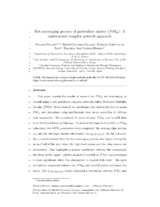Wet scavenging process of particulate matter (PM10): A multivariate complex network approach
Autor
Plocoste, Thomas
Carmona-Cabezas, Rafael
Gutiérrez de Ravé Agüera, Eduardo
Jiménez-Hornero, Francisco José
Editor
ElsevierFecha
2021Materia
PM10Wet scavenging
Multiplex visibility graphs
Complex networks
Caribbean area
METS:
Mostrar el registro METSPREMIS:
Mostrar el registro PREMISMetadatos
Mostrar el registro completo del ítemResumen
This paper reports the results of research on PM10 wet scavenging by rainfall using a new multilayer complex networks called Multiplex Visibility Graphs (MVG). To the best of our knowledge, this work is the first to assess PM10 wet deposition using multivariate time series according to African dust seasonality. We considered 11 years of daily PM10 and rainfall data from the Guadeloupe archipelago. To analyse the impact of rainfall on PM10 behaviour, two MVG parameters were computed: the average edge overlap (ω) and the interlayer mutual information (IPM). On the 1-d scale, the ω results showed that the wet scavenging process was higher during the second half of the year when the high dust season and the rainy season are juxtaposed. This highlights a greater correlation between the microscopic structure of the signal, and the impact of rainfall on PM10 concentrations is more significant when the atmosphere is loaded with dust. The joint probability computed between the PM10 and rainfall nodes confirmed this trend. The IPM results indicated a correlation between PM10 and rainfall structures throughout the year. Furthermore, IPM values were higher during the transition periods between winter and summer (and vice versa). Our study showed that MVG is a powerful technique for investigating the relationship between at least two nonlinear time series using a multivariate time series.
Descripción
Datos de investigación disponibles en: http://www.gwadair.fr

